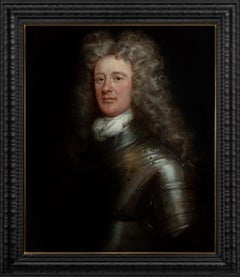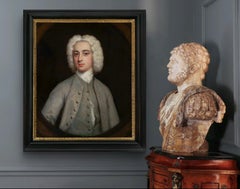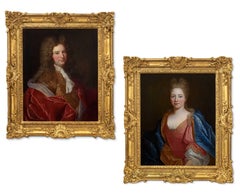Want more images or videos?
Request additional images or videos from the seller
1 of 11
(Studio of) Daniel MytensPortrait of King Charles I c.1633; Antique Oil PaintingCirca 1633
Circa 1633
$28,384.80List Price
About the Item
- Creator:(Studio of) Daniel Mytens (Dutch)
- Creation Year:Circa 1633
- Dimensions:Height: 51.58 in (131 cm)Width: 41.34 in (105 cm)Depth: 2.37 in (6 cm)
- Medium:
- Movement & Style:
- Period:Mid-17th Century
- Condition:Good condition - ready to hang. All paintings have been inspected by one of our conservators prior to going on sale, ensuring condition is very good.
- Gallery Location:London, GB
- Reference Number:1stDibs: LU119918034202
About the Seller
5.0
Vetted Professional Seller
Every seller passes strict standards for authenticity and reliability
Established in 1998
1stDibs seller since 2019
45 sales on 1stDibs
Typical response time: 1 hour
Authenticity Guarantee
In the unlikely event there’s an issue with an item’s authenticity, contact us within 1 year for a full refund. DetailsMoney-Back Guarantee
If your item is not as described, is damaged in transit, or does not arrive, contact us within 7 days for a full refund. Details24-Hour Cancellation
You have a 24-hour grace period in which to reconsider your purchase, with no questions asked.Vetted Professional Sellers
Our world-class sellers must adhere to strict standards for service and quality, maintaining the integrity of our listings.Price-Match Guarantee
If you find that a seller listed the same item for a lower price elsewhere, we’ll match it.Trusted Global Delivery
Our best-in-class carrier network provides specialized shipping options worldwide, including custom delivery.You May Also Like
Portrait of Lady Caroline Price
By George Romney
Located in Miami, FL
DESCRIPTION: Perhaps the best Romney in private hands. If Vogue Magazine existed in the late 18th century, this image of Lady Caroline Price would be ...
Category
1970s Old Masters Portrait Paintings
Materials
Oil, Canvas
18th Century European Portrait of Saint John the Baptist as a Child.
Located in SANTA FE, NM
18th Century European Portrait of a Child Saint John the Baptist
Oil on Canvas
19 x 14 1/4 inches
This lovely and sensitively painting has been examined by a professional restorer w...
Category
18th Century Old Masters Figurative Paintings
Materials
Canvas, Oil
$7,600 Sale Price
20% Off
H 19 in W 14.25 in D 3 in
Italian Greyhound and Friends - Italian 17thC Old Master dog art oil painting
By Francesco Fieravino
Located in Hagley, England
This stunning Old Master 17th century oil portrait painting is attributed to Francesco Fieravino, an artist famous in his day for still lifes and carpets. This painting which dates t...
Category
17th Century Old Masters Animal Paintings
Materials
Canvas, Oil
$57,079 Sale Price
20% Off
H 27 in W 33 in D 2 in
Diogenes looking for a man, studio of Pieter Van Mol, Paris, 17th century, Paris
By Pieter Van Mol
Located in PARIS, FR
Diogenes with his lantern looking for an honest man
Studio of Pieter Van Mol (Antwerp 1599 – Paris 1650)
Paris, mid-17th century
Oil on canvas, h. 44.5 ...
Category
Mid-17th Century Old Masters Figurative Paintings
Materials
Canvas, Oil
$17,309
H 23.62 in W 26.85 in
Fine Italian Old Master Oil Painting Angel & Saints Appearing to Figures
Located in Cirencester, Gloucestershire
Artist/ School: Italian Old Master, 18th century
Title: Angel and Saints appearing to figures, one dressed in a white ruff collar.
Medium: oil on canvas...
Category
Early 18th Century Old Masters Figurative Paintings
Materials
Canvas, Oil
$5,488 Sale Price
20% Off
H 22 in W 26 in
Fine British Aristocratic Portrait of a Nobleman Lord Jeffreys of Wem
Located in Cirencester, Gloucestershire
Portrait of Lord Jeffreys of Wem
British School, 20th century (presumably after an earlier work)
oil painting on canvas, framed
framed: 30.5 x 24.5 inches
canvas: 26 x 20 inches
prov...
Category
20th Century Old Masters Portrait Paintings
Materials
Oil, Canvas
$1,099 Sale Price
20% Off
H 35.5 in W 28.5 in
Fine 18th Century British Portrait of an Aristocratic Lady, Large oil painting
Located in Cirencester, Gloucestershire
Circle of Thomas Hudson (1701-1779) British.
18th Century Bust Portrait of a Lady,
Oil on Canvas, Inscribed on a label verso,
canvas: 30" x 25" (76.2 x 63.5cm).
frame: 30 x 25 in...
Category
Mid-18th Century Old Masters Portrait Paintings
Materials
Canvas, Oil
$2,743 Sale Price
20% Off
H 35 in W 30 in D 1 in
1600's Flemish Old Master Oil Painting The Virgin & Child Mastertpiece Work
Located in Cirencester, Gloucestershire
The Virgin & Child
Flemish School, circa 1600
circle of Cornelis van Cleve (Flemish c. 1520-1614),
oil painting on canvas
canvas: 37 x 30 inches
provenance: private collection, Paris...
Category
Early 17th Century Old Masters Portrait Paintings
Materials
Canvas, Oil
$9,000 Sale Price
54% Off
H 44 in W 36 in D 1 in
Fine Large 17th/ 18th Century English Portrait of Mr. Gilbert Charity Founder
Located in Cirencester, Gloucestershire
Portrait of Mr. Gilbert (believed to be the founder of 'Gilberts Charity, Bridgwater, Somerset)
English School artist, late 17th/ early 18th century
oil...
Category
Late 17th Century Old Masters Portrait Paintings
Materials
Oil, Canvas
$2,199 Sale Price
20% Off
H 30 in W 25 in
17th Century Italian Old Master Oil Painting Moses Striking Water from the Rock
By Pier (Pietro) Dandini
Located in Cirencester, Gloucestershire
Moses Striking Water from the Rock;
Circle of Pietro Dandini, Italian 1646-1712
Italian School, late 17th century
oil on canvas, framed
framed: 3...
Category
Early 18th Century Old Masters Portrait Paintings
Materials
Canvas, Oil
$6,860 Sale Price
20% Off
H 32 in W 28 in D 1 in
More From This Seller
View AllPortrait of a Gentleman, David Erskine, 13th Laird of Dun, Wearing Armour c.1700
Located in London, GB
The gentleman in this exquisite oil on canvas portrait, presented by Titan Fine Art, is shown with the grandiloquence characteristic of the English School of painting. He is portray...
Category
17th Century Old Masters Portrait Paintings
Materials
Oil, Canvas
Portrait of a Gentleman in Grey Coat & White Cravat, Oil on canvas Painting
Located in London, GB
This exquisite work, presented by Titan Fine Art, is by the notable artist Hans Hysing, who was a noteworthy painter in England; it is significant in its q...
Category
18th Century Old Masters Portrait Paintings
Materials
Canvas, Oil
Portrait of Gentleman Blue & Cloak, Portrait of Lady, Fine Carved Gilded frames
Located in London, GB
Portrait of a Gentleman with Blue Cloak and Portrait of a Lady in Russet Dress c.1697
Thomas Murray (1663-1735)
These fascinating portraits are exquisite examples of portraiture in ...
Category
17th Century Old Masters Portrait Paintings
Materials
Oil, Canvas
Portrait of a Lady and Portrait of Gentleman, Velvet & Silk Attire c.1700 French
By Nicolas de Largillière
Located in London, GB
These lavish portraits, presented by Titan Fine Art, illustrate the elegant and exuberant type of portrait that the French court and the bourgeoisie favoured at the end of the 17th century. Painted circa 1700, they combine a meticulous representation of the subject's face and rich detailed draperies. They are a mastery of colour and of a style perfected by the prestigious painter and Director of the Académie Royale de Peinture et de Sculpture in Paris, Nicolas de Largilliere.
France during this period was the leading exponent of fashion and the arts to the rest of Europe and the fashions arose from the French court itself – and this is evident in the clothing on display in these portraits. The gentleman has been depicted in a russet coat with golden thread embroidery, a white lace cravat, and a rich crimson velvet mantle, that has been deliberately turned over at the top to reveal its purple shot silk lining. The young beautiful lady, whose face is painted with a clear and fresh palette, wears a dress with golden embroidery on the bodice and a huge black diamond brooch, large balloon-like gathered sleeves with lace and tied with a string of pearls, and a luxurious azure blue velvet mantle, tied at the shoulder with a pearl and large diamond brooch, again, deliberately folded to reveal its real gold embroidered lining. Her cheeks are rosy, with red lips: a style in keeping with that was worn at Versailles. The copious number of expensive fabrics, that completely encircle them, serve to underline their social status.
The skilful works, with their beautiful colour combinations, create a strong visual impact. The artist demonstrates great skill in the rendering of sumptuous fabrics, the use of vibrant colours, and the realism of the faces.
The couple are most likely married, considering the conventions of portraiture at the time, where the male is positioned on the left (and inclined to our right) and the female is positioned on the right (and included to our left).
A feature of these portraits are the stunning original carved and gilded frames – they are works of art in their own right.
Nicolas de Largillierre was baptised in Paris in 1656. His family relocated to Antwerp when he was approximately three years old. After a journey to London, Largillière's father arranged for him to apprentice with the Flemish artist Anton Goubau. Nevertheless, he departed at the age of eighteen and returned to England, where he formed a friendship and was employed by Sir Peter Lely for four years in Windsor, Berkshire. During this period, Largillière also worked under the guidance of the Italian painter Antonio Verrio.
His artwork garnered the interest of Charles II, who desired to keep Largillière in his service; however, he eventually returned to Paris, where he was warmly embraced by the public as a painter.
Upon his ascension to the throne in 1685, James II summoned Largillière back to England and offered him the position of keeper of the royal collections. He subsequently painted portraits of the king, Queen Mary of Modena...
Category
17th Century Old Masters Portrait Paintings
Materials
Canvas, Oil
Portrait of a Lady White Dress & Blue Cloak, Frances Temple Lady Berkeley canvas
By Michael Dahl
Located in London, GB
Portrait of a Frances Temple Lady Berkeley in a White Dress and Blue Mantle c.1695
By Michael Dahl (1659-1743)
This elegant and graceful portrait, presented by Titan Fine Art, was p...
Category
17th Century Old Masters Portrait Paintings
Materials
Cotton Canvas, Oil
Portrait of a Lady, Elizabeth Fane, Countess Westmoreland in Silver Dress, oil
By John Michael Wright
Located in London, GB
Portrait of a Lady, Elizabeth Fane, Countess Westmoreland in Silver Dress c.1667
Circle of John Michael Wright (1617-94)
In this touching composition, painted around the time of Lon...
Category
17th Century Old Masters Portrait Paintings
Materials
Cotton Canvas, Oil



